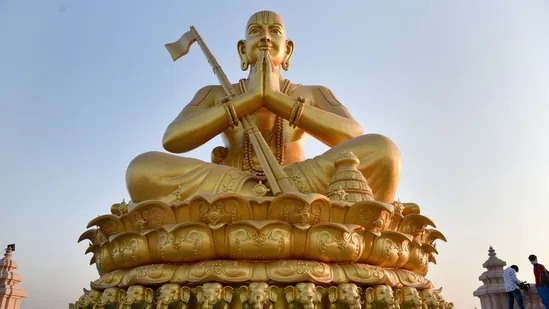Indian History
Philosopher-saint Ramanujacharya
- 04 Feb 2022
- 5 min read
For Prelims: Ramanujacharya, Bhakti movement, Statue of Equality.
For Mains: Ramanujacharya and his role in Bhakti movement and achieving social equality, Statue of Equality and its Significance.
Why in News ?
The Prime Minister will inaugurate the Statue of Equality, a statue of Ramanujacharya, on the outskirts of Hyderabad, Telangana.
- India is celebrating his 1,000th birth anniversary as the ‘Festival of Equality’, upholding the view that the world is one family, ‘vasudhaiva kutumbakam’,”
What Are the Basic Facts About Statue ? 
- It is a 216-feet tall statue, which is made of 'panchaloha', a combination of five metals: gold, silver, copper, brass, and zync.
- It is among one of the tallest metallic statues in sitting position in the world.
- The statue is mounted on a 54-feet high base building named 'Bhadra Vedi'. It has floors devoted for a vedic digital library and research center, ancient Indian texts, a theater, an educational gallery detailing many works of Sri Ramanujacharya.
Who was Ramanujacharya ?
- Born in 1017 in Sriperumbudur in Tamil Nadu, Ramanujacharya is revered as a Vedic philosopher and social reformer.
- He was named Lakshmana at the time of his birth. He was also referred to as Ilaya Perumal which means the radiant one.
- He traveled across India, advocating equality and social justice.
- He revived the Bhakti movement, and his preachings inspired other Bhakti schools of thought. He is considered to be the inspiration for poets like Annamacharya, Bhakta Ramdas, Thyagaraja, Kabir, and Meerabai.
- He is famous as the chief proponent of Vishishtadvaita subschool of Vedānta.
- VishishtAdvaita (literally "Advaita with uniqueness; qualifications") is a non-dualistic school of Vedanta philosophy.
- It is non-dualism of the qualified whole, in which Brahman alone is seen as the Supreme Reality, but is characterized by multiplicity.
- He went on to write nine scriptures known as the navaratnas, and composed numerous commentaries on Vedic scriptures.
- Ramanuja’s most important writings include his commentary on the Vedanta Sutras (the Sri Bhasya, or "True Commentary"), and his commentary on the Bhagavad-Gita (the Gitabhasya, or "Commentary on the Gita").
- His other writings include the Vedartha Samgraha ("Summary of the Meaning of the Veda"), the Vedantasara ("Essence of Vedanta"), and Vedantadipa ("Lamp of Vedanta").
- He has also stressed the need of being in tune with nature and not to over-exploit.
Why is it called the Statue of Equality ?
- Ramanuja was an advocate of social equality among all sections of people centuries ago, and encouraged temples to open their doors to everyone irrespective of caste or position in society at a time when people of many castes were forbidden from entering them.
- He took education to those who were deprived of it. His greatest contribution is the propagation of the concept of “vasudhaiva kutumbakam”, which translates as “all the universe is one family”.
- He traveled across India for several decades, propagating his ideas of social equality and universal brotherhood from temple podiums.
- He embraced the socially marginalized and condemned, and asked royal courts to treat them as equals.
- He spoke of universal salvation through devotion to God, compassion, humility, equality, and mutual respect, which is known as Sri Vaishnavam Sampradaya.
- Ramanujacharya liberated millions from social, cultural, gender, educational, and economic discrimination with the foundational conviction that every human is equal regardless of nationality, gender, race, caste, or creed.




